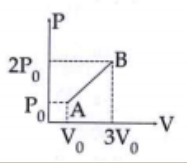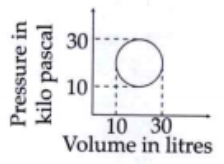Complete Solutions to EXERCISE of chapter Thermodynamics of Class 12 book with complete answers and questions
| Class 12 | PHYSICS |
| Chapter | Thermodynamics |
| CHETANA PUBLICATION | EXERCISE |
| Number Of Questions | 76 |
| Academic Year | 2023-24 |
A gas initially at `17^@C` issuddenly compressed to 1/8 of its original volume. Find the temperature after compression ? [gamma` = frac(5)(3)]`
03:55View SolutionA gas expands from 75 litres to 125 litres at constant pressure of 4 atmosphere. Find the work done by the gas during this expansion.
01:43View SolutionWhen the temperature of 5 mol of a gas is changed from `100^@C` to `120^@C` keeping the volume constant, the change in internal energy of the gas is 80 J, then find the heat capacity of the gas at constant volume.
02:17View Solution5 mol of oxygen is heated at constant volume from `10^@C` to `20^@C`. Find the change in internal energy of the gas
03:41View SolutionAn amount of heat of 100 cal is supplied to a gas. The work done by the gas is 210 J. Find the increase in internal energy.
01:37View Solution400 J of work is performed on a gasfor reducing its volume by compression. If the change is done adiabatically, whatisthe amount of heat absorbed by it?
02:30View SolutionA cylinder contains one gram mole of `H_2` at `17^@C` and 2 atms. The initial volume of the gas is `2xx10(-3)m^3`. Find the work done if its volume changes by 15 percent.
03:41View SolutionIn a thermodynamic process 400 J of heat is given to a gas and 100 J of work is also done on it. Find the change in the internal energy of the gas.
01:45View SolutionIf 5 moles of oxygen at STP is adiabatically compressed so that temperature increases to `400^@C`, then find the work done on the gas. R=8.3J/mole−K
03:18View Solution70 calories of heat is required to raise the temperature 2 moles of an ideal gas at constant pressure from `30^@C` to `35^@C`. What is the amount of heat required to raise the temperature of the same gas from `30^@C` to `35^@C` at constant volume?
03:33View SolutionIf 1200 calories of heat is removed from a gas which is held at constant volume, what is the change in internal energy of the system?
01:43View SolutionThe volume of 1 kilomole of an ideal gas increases isothermally from 1 litre to 10 litres at `27^@C`. If the universal gas constant is 8312 `Jkmol^(-1)K^(-1)`, calculate the work done.
02:25View SolutionWork done for the rise of one mole of helium gas adiabatically through `2^@C` is W. What is the work done for the rise of one mole of hydrogen gas adiabatically through `2^@C`?
04:10View SolutionA diatomic gas at pressure P and volume V is compressed adiabatically to `frac(1)(32)` times the original volume. Find the final pressure.
03:08View SolutionDuring an adiabatic process, if the pressure of an ideal gas is proportional to the cube of its temperature, find f value.
01:43View SolutionCalculate the efficiency of a Carnot's engine working between steam point and ice point.
01:47View SolutionA Carnot engine takes in 1000 k cal of heat from a reservoir at `627^@C` and exhausts heat to sink at `27^@C`. What is the efficiency?
02:31View SolutionA Carnot engine whose low temperature reservoir is at `7^@C` has an efficiency of 40. It is desired to increase the efficiency to `50%`. By how many degree must the temperature of the high temperature reservoir be increased?
03:44View SolutionA refrigerator has to transfer an average of 263 J of heat per second from temperature `(-10)^@C` to `25^@C`. Calculate the average power consumed assuming ideal reversible cycle and no other losses.
03:46View SolutionRefrigerator A works between `(-10)^@C` and `27^@C` while refrigerator B works between `-20^@C` and `17^@C`, both removing heat equal to 2000 J from the freezer. Which of the two is the better refrigerator?
04:49View SolutionFor a given amount of gas at a given temperature when volume is ten folded isothermally, the work done is x. What is the work done for the same amount of gas at the same temperature, if the volume is hundred folded?
01:42View SolutionThermal equilibrium implies the equality of
02:00View SolutionThe direction of flow of heat between two bodies is determined by
01:44View SolutionA quantity of heat Q issupplied to a monoatomic ideal gas, which expands at constant pressure. The fraction of heat that goes into work done by the gasis
02:46View SolutionAn adiabatic process occurs at constant
01:31View SolutionIn an adiabatic expansion of a gas
02:02View SolutionWhen a gas expands adiabatically
02:42View SolutionThe pressure temperature relationship for an ideal gas undergoing adiabatic change is
07:03View SolutionA gas is compressed at a constant pressure of 50 Pa from a volume `10 m^3` to a volume of `4 m^3`. If 100 J of heat is added to the gas, then its internal energy.
02:38View SolutionTwo samples A and B of a gas initially of the same temperature and pressure are compressed from a volume V to a volume `frac(V)(2)` such that A is compressed isothermally and B adiabatically. The final pressure of
04:04View SolutionA quantity of heat Q issupplied to a monoatomic ideal gas, which expands at constant pressure. The fraction of heat that goes into work done by the gasis
02:46View SolutionStarting with same initial conditions, an ideal gas expands from volume `V_1` to `V_2` in three different ways. The work done by the gas is `W_1` if the process is purely isothermal, `W_2` if purely isobaric and `W_3` if purely adiabatic. Then
03:52View SolutionAn ideal gas A and a real gas B have their volumesincreased fromV to2V under isothermal conditions. The increase in internal energy
02:39View SolutionFor a gas undergoing an adiabatic process, the relation between temperature and volume is found to be `TV^(@.4)` = constant. The gas may be
02:12View SolutionThe internal energy of a gas decreases by an amount equal to the external work, the gas is undergoing
02:29View SolutionIn a cyclic process
02:10View Solution`delta Q` = `delta U` is true for
02:19View SolutionFor isothermal expansion of perfect gas, the value of `delta fra(P)(P)` is equal to
02:01View SolutionFour curves A, B, Cand Dare drawn in the figure for a given amount of gas. The curves which represent adiabatic and isothermal changes are
 06:01View Solution
06:01View SolutionA given mass of a gas expands from state A to state B by three paths 1, 2 and 3 as shown in the figure. If `W_1`, `W_2` and `W_3` respectively are the work done by the gas along the three paths, then. br>
 02:58View Solution
02:58View SolutionIf` w_1` and `w_2` are the amounts of work done in the given two indicator diagrams, then br>
 04:02View Solution
04:02View SolutionIn the indicator diagram shown, the work done along the path AB is br>
 04:08View Solution
04:08View SolutionIn the indicator diagram shown, the work done in the cyclic process is br>
 02:03View Solution
02:03View SolutionThe internal energy of air in a room of volume `40 m^3` atstandard atmospheric pressure is
03:12View SolutionA gas undergoes a change of state during which 100 J of heat is supplied to it does 20 J of work. The system is brought back to its original state through a process during which 20 J heat is released by the gas. The work done by the gas in the second processes.
02:30View SolutionThe amount of work done to increase the temperature of one mole of an ideal gas by `30^@C`, if it expands under the condition `VpropT^frac(2)(3)` is
03:35View SolutionTwo engines A and B have their sources at 400 K and 350 K and sinks at 350 K and 300 K respectively. Which is more efficient and by how much ?
02:41View SolutionIf two thirds of the heat taken by a heat engine from the source is given to the sink, its efficiency is
02:13View SolutionThe efficiency of a heat engine is `20%`, when the working substance is hydrogen. Its efficiency if hydrogen is replaced by oxygen is
01:33View SolutionIf the absolute temperatures of the source and sink of a heat engine are in the ratio `4 : 3`, its efficiency is
01:40View SolutionTwo Carnot engines A and B are operated in series. A receives heat at 900 K and rejects it to the reservoir at TK. B receives the rejected heat from Aand rejectsit to itsreservoir at 400 K. If the work outputs of A and B are equal, then T is
05:50View SolutionA refrigerator has a coefficient of performance 9. If the surrounding temperature is `27^@C`, the minimum temperature it can cool a body inside is
02:34View SolutionA refrigerator works between `0^@C` and `27^@C`. If heat is to be removed from the refrigerated space at t/rate of 50 kcal/minute, the power of the motor of the refrigerator should be
03:13View SolutionA gas in a closed container is heated with 10 J of energy , causing the lid of the container to rise 2 m with 3 N of force. What is the total change in energy of the system ?
01:25View SolutionWhich of the following is an example of the first law of thermodynamics ?
02:06View SolutionEfficiency of a Carnot engine is large when
01:11View SolutionThe second law of thermpdynamics deals with transfer of
01:58View SolutionDuring refrigration cycle, heat is rejected by the refrigerant in the
01:26View SolutionSelect and write correct alternative from the following alternatives: The indicator diagrams representing maximum and minimum amounts of work done are respectively:
 02:30View Solution
02:30View SolutionState first law of thermodynamics.
04:20View SolutionWork done during expansion is positive. Explain.
03:58View SolutionState zeroth law of thermo dynamics? OR Give the characteristics of isobaric process.
04:34View SolutionDraw a neat labelled diagram to show the energy flow of heat engine.
01:37View SolutionState both the statements of second law of thermodynamics.
03:30View SolutionMention the set of processesin a Carnot cycle.
03:57View SolutionDistinguish between Reversible and Irreversible process.
05:11View Solution5 mol of oxygen is heated at constant volume from `10^@C` to `20^@C`. Find the change in internal energy of the gas
03:41View SolutionAn amount of heat of 100 cal is supplied to a gas. The work done by the gas is 210 J. Find the increase in internal energy.
01:37View SolutionAn ideal gasin a cylinder is compressed adiabatically to one-third its original volume. During the processif 45 J of work is done on the gas by the compressing agent, what is the change in internal energy?
02:35View SolutionDerive an expression for efficiency of Carnot cycle.
05:01View SolutionDerive an expression for work done in adiabatic process.
03:54View SolutionExplain the working of a refrigerator with energy flow diagram?
05:18View SolutionA Carnot engine absorbs 1000 J of heat from a reservoir at `127^@C` and rejects 600 J of heat during each cycle.Calculatethe temperature of the sink
02:36View SolutionA Carnot engine absorbs 1000 J of heat from a reservoir at `127^@C` and rejects 600 J of heat during each cycle.Calculatethe amount of the useful work done during each cycle.
02:02View SolutionWhat isthe process modification in sterling cycle compared to Carnot.
04:35View Solutionwhat are the uses of sterling cycle.
02:11View Solution
EXERCISE questions and complete solutions for chapter Thermodynamics of CHETANA PUBLICATION of Class 12
